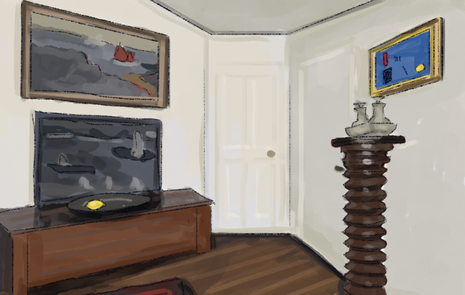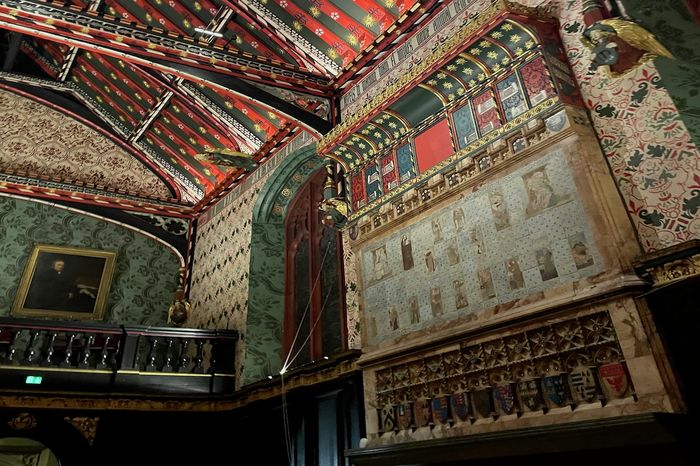What the lemon taught me
Inspired by the Kettle’s Yard lemon, Ella Howard reflects on the importance of noticing the small things in life

On a small side table in Kettle’s Yard lies a lemon, carefully placed and all alone on the plate. This lemon, whilst seemingly innocuous, is essential to the room’s aesthetic harmony, in dialogue with a yellow dot on the painting beside. Or, at least, so the guide tells me.
When I first visited Cambridge’s most unique art gallery last year, the supposed significance of the lemon struck me as ridiculous, an unnecessary gimmick. This was certainly not helped by the absurd fact of having a dedicated staff member to purchase and place the lemon, for no one else, I was told, is allowed to touch it.
I am all too familiar with the constant drive to analyse, to read into each and every word, a practice that can be exhausting at times; the lemon, therefore, seemed an unwelcome symptom of the Cambridge mind, a pretentious and performative over-attention to detail.
“This lemon, whilst seemingly innocuous, is essential to the room’s aesthetic harmony, in dialogue with a yellow dot on the painting beside”
Yet, on my recent return to Kettle’s Yard with my parents, I have found a new appreciation for the little fruit, and have even begun to think it may just be what makes the place so very special.
Now, if you’ll let me diverge from fruit for just a moment, I must first touch on another material object: rocks.
At Kettle’s Yard, pebbles are arranged in swirling rings, scattered throughout the home’s many rooms – one on the mantlepiece, some here on the windowsill. As a plaque reads in the couple’s front room, “KETTLE’S YARD, CAMBRIDGE, ENGLAND IS THE LOUVRE OF THE PEBBLE”. Like an Easter egg hunt, my mum spotted these tiny rocks, pointing them out to us as we walked along.
Beyond the aesthetic organisations of shade and size, the pebbles began to form part of a larger pattern, a rocky trail hidden across the house for those, like my mum, who notice.
It is that last word that was so important to the owners of Kettle’s Yard – and now to me – for their home is a masterclass in noticing, a timely reminder to stop and smell the roses.
Paintings, for example, are often hung low, placed not at eye height but at knee height, easy to miss and peculiarly drawing the sight down. However, thanks to an abundance of expertly placed chairs, we are encouraged to stop, to physically pause and truly look at the art, which is certainly worthy of more than a passing glance.
“The visitor is encouraged to make aesthetic connections, to challenge their traditional conceptions of space, colour, and art”
Indeed, the whole house serves as a gentle reminder to slow down, an ethos embodied even in its architecture; the rooms gradually unfurl before you, a twisting maze of cottages that disguise the building’s true size – you must take each room as it comes and entirely for itself.
It is no wonder, therefore, that the lemon was spotlighted by my guide in their introduction, for not only is it conveniently placed by the doorway of the first cottage, but it perfectly encapsulates the artistic heart of the house. Like the pebbles and the paintings, the visitor is encouraged to make aesthetic connections, to challenge their traditional conceptions of space, colour, and art.
Kettle’s Yard does not demand but instead gently directs our attention, serving as a much-needed antidote to Cambridge’s relentless hustle and bustle. Yet, it was still a place that I couldn’t quite appreciate on my first visit.
Don’t get me wrong, I certainly admired the beauty of the space and the clever contrasts between light and shade, but I (and my friends) laughed at the lemon. That is not to say I have lost all humour for the fruit – I do still love the absurdity of a dedicated lemon-buyer – but it took the outside perspective of my parents to change my mind.
Whether it be aversion or appreciation, the lemon lives up to its sour flavour, provoking an emotional and valuable reaction in the viewer; art does not have to be made of paint and canvas, nor must it even be judged as good. Art, as Kettle’s Yard has taught me, must merely demand that we notice it and for a brief moment consider the wonderfully commonplace world around us.
 Features / Should I stay or should I go? Cambridge students and alumni reflect on how their memories stay with them15 December 2025
Features / Should I stay or should I go? Cambridge students and alumni reflect on how their memories stay with them15 December 2025 News / Cambridge study finds students learn better with notes than AI13 December 2025
News / Cambridge study finds students learn better with notes than AI13 December 2025 News / Dons warn PM about Vet School closure16 December 2025
News / Dons warn PM about Vet School closure16 December 2025 News / News In Brief: Michaelmas marriages, monogamous mammals, and messaging manipulation15 December 2025
News / News In Brief: Michaelmas marriages, monogamous mammals, and messaging manipulation15 December 2025 Comment / The magic of an eight-week term15 December 2025
Comment / The magic of an eight-week term15 December 2025









